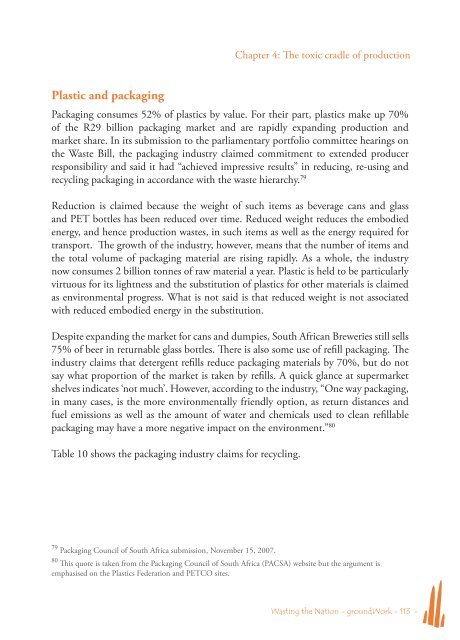Wasting the Nation.indd - Groundwork
Wasting the Nation.indd - Groundwork
Wasting the Nation.indd - Groundwork
Create successful ePaper yourself
Turn your PDF publications into a flip-book with our unique Google optimized e-Paper software.
Chapter 4: The toxic cradle of productionPlastic and packagingPackaging consumes 52% of plastics by value. For <strong>the</strong>ir part, plastics make up 70%of <strong>the</strong> R29 billion packaging market and are rapidly expanding production andmarket share. In its submission to <strong>the</strong> parliamentary portfolio committee hearings on<strong>the</strong> Waste Bill, <strong>the</strong> packaging industry claimed commitment to extended producerresponsibility and said it had “achieved impressive results” in reducing, re-using andrecycling packaging in accordance with <strong>the</strong> waste hierarchy. 79Reduction is claimed because <strong>the</strong> weight of such items as beverage cans and glassand PET bottles has been reduced over time. Reduced weight reduces <strong>the</strong> embodiedenergy, and hence production wastes, in such items as well as <strong>the</strong> energy required fortransport. The growth of <strong>the</strong> industry, however, means that <strong>the</strong> number of items and<strong>the</strong> total volume of packaging material are rising rapidly. As a whole, <strong>the</strong> industrynow consumes 2 billion tonnes of raw material a year. Plastic is held to be particularlyvirtuous for its lightness and <strong>the</strong> substitution of plastics for o<strong>the</strong>r materials is claimedas environmental progress. What is not said is that reduced weight is not associatedwith reduced embodied energy in <strong>the</strong> substitution.Despite expanding <strong>the</strong> market for cans and dumpies, South African Breweries still sells75% of beer in returnable glass bottles. There is also some use of refill packaging. Theindustry claims that detergent refills reduce packaging materials by 70%, but do notsay what proportion of <strong>the</strong> market is taken by refills. A quick glance at supermarketshelves indicates ‘not much’. However, according to <strong>the</strong> industry, “One way packaging,in many cases, is <strong>the</strong> more environmentally friendly option, as return distances andfuel emissions as well as <strong>the</strong> amount of water and chemicals used to clean refillablepackaging may have a more negative impact on <strong>the</strong> environment.” 80Table 10 shows <strong>the</strong> packaging industry claims for recycling.79 Packaging Council of South Africa submission, November 15, 2007.80 This quote is taken from <strong>the</strong> Packaging Council of South Africa (PACSA) website but <strong>the</strong> argument isemphasised on <strong>the</strong> Plastics Federation and PETCO sites.<strong>Wasting</strong> <strong>the</strong> <strong>Nation</strong> - groundWork - 113 -
















